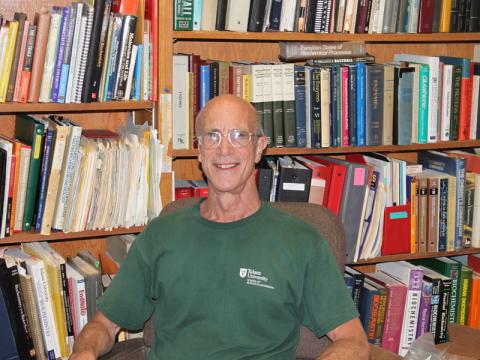
Office
5045 Stern Hall
Education & Affiliations
Biography
The primary research interest of our group is the mechanism of action of enzymes. Our recent work has focused on the hydrolytic enzymes, ß-glucosidase and hyaluronidase, and the glycolytic enzyme, glyceraldehyde-3-phosphate dehydrogenase. In order to better understand the sources of the enormous catalytic efficiency, specificity and regulatory properties of enzymes we are making use of the classical probes of physical organic chemistry (e.g., structure-reactivity relationships and kinetic isotope effects). As a further probe of enzyme mechanisms we also make use of transition state analog inhibitors. These are stable compounds designed to resemble fleeting intermediates. Because of this resemblance they are bound by the enzyme much more tightly than are substrates. The more closely a transition state analog resembles the transition state the more tightly it should bind to the enzyme. Thus, we can get mechanistic information (i.e., transition state structure) by looking at reversible inhibitors.
The approach of using transition state analogs as enzyme inhibitors is useful not only in elucidating some of the structural features of the transition state but also as a basis for drug design. Indeed, there is an increasing number of drugs available which have been designed as transition state analogs for a variety of enzymes. Transition state analogs are also used in developing catalytic antibodies which can carry out reactions for which no known enzymes exist.
Area of current interest:
- Bio-Organic Chemistry
Selected Publications
K. Wang, X. Cai, W. Yao, D. Tang, R. Kataria, H.S. Ashbaugh, L.D. Byers and B.C. Gibb, “Electrostatic Control of Macrocyclization Reactions within Nanospaces” J. Am. Chem. Soc. 141, 6740-6747 (2019)
M. Xie and L.D. Byers, “Solvent and "-Secondary Kinetic Isotope Effects on β-Glucosidase” Biochim. Biophys. Acta 1854, 1776-1781 (2015)
E.A-B Avegno, G.S. Howarth, A. V. Demchenko and L.D. Byers, “Reactive Thioglucoside Substrates for β-Glucosidase” Arch. Biochem. Biophys. 537, 1-4 (2013)
Y Na, H Shen, Byers, LD, N-Phenylglucosylamine Hydrolysis: A Mechanistic Probe of β-Glucosidase, Bioorganic Chemistry, 39, 111-113 (2011)
Alverson-Banks, E and Byers, LD, Multiple Inhibition of β-Glucosidase, Am Chem Soc (2011).
EG Golden and LD Byers, A Search for a Solvent Isotope Effect on a-Glucosidase, FASEB Journal (2008).
AH O'Donnell, X. Yao and LD Byers, Solvent Kinetic Isotope Effects on α-Glucosidase, Biochem. Biophys. Acta., 1703, 63 (2004).
EM Bowers, LO Ragland and LD Byers, Specific Ion Effects on β-Glucosidase, FASEB Journal, 18, C140 (2004).
EB Golden, AE O'Donnell and LD Byers, Solvent Isotope Effects on Binding to Glucosidases, FASEB Journal, 17, A983 (2003).
X. Yao, R. Mauldin and L. Byers, AMultiple Sugar Binding Sites in α-Glucosidase, Biochim. Biophys. Acta, 1645, 22 (2003).
L.O. Ragland and L.D. Byers, Salt Effects on β-Glucosidase Kinetics, FASEB Journal 16, A535 (2002).
X. Yao, R. Mauldin and L. Byers, Multiple Sugar Binding Sites in Glucosidase, Biochim. Biophys. Acta, 1645, 22 (2003).
D. Nguyen and L. D. Byers, A α-Glucosidase Inhibition by Imidazoles, FASEB Journal 15, 1160 (2001).
